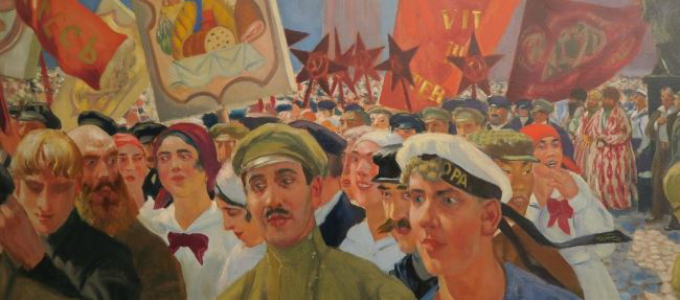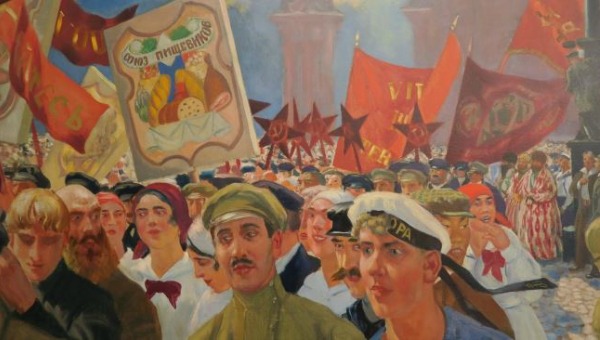 REVOLUTION: NEW ART FOR A NEW WORLD is a feature documentary that encapsulates a momentous period in the history of Russia and the Russian Avant-Garde. Jim Moore spoke to director Margy Kinmonth about the political upheaval and creative innovation which formed the catalyst for this “revolution”.
REVOLUTION: NEW ART FOR A NEW WORLD is a feature documentary that encapsulates a momentous period in the history of Russia and the Russian Avant-Garde. Jim Moore spoke to director Margy Kinmonth about the political upheaval and creative innovation which formed the catalyst for this “revolution”.
Jim Moore: What was the origin of REVOLUTION, and how did you plan to tell the story?
Margy Kinmonth: My film brings the artists of the Russian Avant-Garde to life, drawing on the collections of major Russian institutions, contributions from contemporary artists and performers, with personal testimony from the descendants of those involved. It tells the stories of artists like Chagall, Kandinsky, Malevich and others – pioneers who flourished in response to the Utopian challenge of building a New Art for a New World, only to be broken by implacable authority after 15 short years.
The genesis for REVOLUTION came after a period of filming in Russia, and I’ve now directed four major films in Russia. Why Russia? As a filmmaker I find rich stories in Russian history and art, which continually resonate with me. There’s a deep well of art and culture, writing, music, film and architecture through which to tell Russia’s stories. But most of all, it’s the peoples’ stories that draw me in.
JM: How did you approach the descendants of the artists profiled, and what effect did it have on the film as released?
MK:I wanted my film to come from Russia itself. I was amazed to find out how many of the artists’ descendants are still practicing artists today, keen to celebrate their grandparents’ legacy and to tell their stories of survival, and some of heartbreaking loss. It was great to film in the art schools in Moscow and St Petersburg, and many of the young artist students took part in the filming. Alexander Lavrentiev, the grandson of the great photographer contructivist Aleksander Mikhailovich Rodchenko, and grandson of artist Varvara Stepanova, who is a teacher and clearly inherited his grandparents’ talents, allowed me to film his photography class at the Stroganoff Institute; his students were having so much fun.
The reason I made this film was to champion the role of the artists in this tumultuous political period of the 1917 Russian Revolution, in order to understand the context, but most of all to enjoy and be inspired by some of the most inventive and brilliant works of art the world has ever known.
JM: What was the process behind gaining access to the museums to view previously unseen artworks?
MK:At first I found that the art of the Avant Garde seemed little to be seen publicly in Russia itself. It was largely tucked away behind the scenes in stores and archives, or else has long since been absorbed into the West. I found the crowds who flock and queue to see Russian Avant Garde art in Western museums were not much in evidence in the galleries in Russia. I discovered that the propaganda monumental sculptures commissioned by Lenin had long since disintegrated, famous Revolutionary modernist theatre techniques like Biomechanics were rarely practiced in Russia, buildings of famous constructivist style were decaying in disrepair and falling down. In fact, despite it being a period of intense, unique creativity, one to be proud of, I actually discovered when I started to interview contributors, that the Revolutionary and especially post Revolutionary period, was a chapter of Russian history which had been effectively filed away – a period of history which nobody wanted repeated.
I made repeated requests to film in the main C20th art institutions in Moscow and St Petersburg, and it took a very long time to get access. Then I had a breakthrough, I had enormous support from the State Tretyakov Gallery from the impressive director Zelfira Tregulova, who is a keen internationalist in the world of museology, encouraging openness, sharing scholarship and making important loans to other museums in the West. She was very generous in allowing me to film both in the galleries and behind the scenes with different curators. Tregulova’s interview in the film is revealing, bringing extensive knowledge of Russian political history and how it shaped the art of the Revolutionary period.
Women artists in particular flourished through their emancipation…
JM: Can you tell us about the connections made across different types of art (film, theatre, photography) during the post-Revolutionary period?
MK:It was an incredibly fruitful period with art flourishing across all fields of culture. The painters were a leading force, as they had already established the Russian Avant Garde movement at the beginning of the century, when Modernism was sweeping across Europe. Many of the artists collaborated with one another across the art forms – design, posters, film, theatre sets, costumes, propaganda art, architecture, early advertising. It was all very political. Women artists in particular flourished through their emancipation, having just got the vote, and their legacy from that period is astonishing. Very colorful and dynamic.
I became increasingly interested in what happened to Russia culturally during the Revolution, and started searching for stories and artefacts. 1917 was a pioneering period for the cinema itself and I found rare, unseen footage in the film archive at Krasnogorsk, of the Russian Avant Garde period. One of my starting points for my film REVOLUTION was the great epic film “October” by Eisenstein, a story which was in itself a propaganda exercise and which immortalised the political events through the lens of a great artist. It was Lenin himself who decided that Art was the means to spread the communist ideology, so, as a result, many artists played a key role at the centre of the Russian Revolution. I knew there was a whole story to be told about the artists themselves and how their experiences were so intertwined with political events and the creation of propaganda. A very different scenario to today’s art world.
As a director, I always love working with actors to bring the story to life, to explore the internal monologue and emotions of the characters. REVOLUTION features the voices of some of the most exciting actors working today. They portray the key players of the Russian Revolutionary period of the Avant Garde movement – Matthew MacFadyen plays Vladimir Lenin, with Tom Hollander, James Fleet, Eleanor Tomlinson and Daisy Bevan heading up the cast as artists Kazimir Malevich, Wassily Kandinsky, Lyubov Popova and Varvara Stepanova.
JM: How did artists in the USSR and the West influence each other during this
period?
MK: One very powerful influence came largely from France. The works of Picasso, Matisse and Derain, to name a few, had been shown in Moscow in the early C20th, in collections of the industrialists Sergei Shchukin and Ivan Morozov, who were big collectors and patrons of the French post impressionists. The Russian artists were inspired and excited by what they saw and many travelled to Paris to see what was going on. Then they brought the ideas back to Russia and made them all far more extreme in the political melting pot of the Revolutionary period. However, in the other direction, some artists like Wassily Kandinsky left Russia forever, he took his ideas onward to Germany to the Bauhaus movement.
JM: Are there any further movements or periods in Soviet art you wanted to investigate but were unable to?
MK: Yes I would like to investigate the influence that the Russian Revolutionary art had upon other Revolutions, especially China. I know it played a huge role. It would make a fascinating film, how it came about, but I haven’t got that far round the world yet!
REVOLUTION: NEW ART FOR A NEW WORLD is in cinemas nationwide tonight, 10 November, for one night only! http://revolution.film/
httpvh://youtu.be/u-B1D2eIXU0

